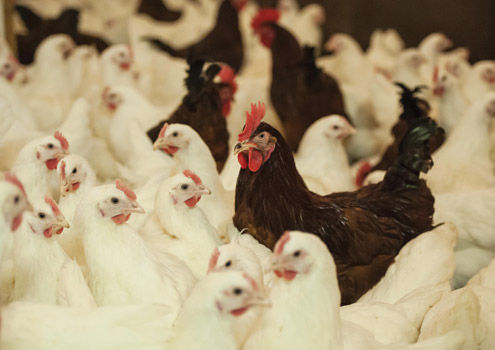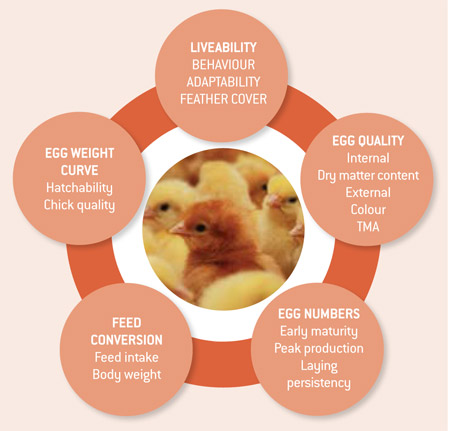Poultry breeders aim to meet society’s wider demands

The world of layer breeding is changing fast, with new methods and new priorities. Philip Clarke talks to leading researchers at Hendrix Genetics, the company behind the ISA layer breeds, distributed in the UK by Joice and Hill
Breeding layers used to be a simple business, employing conventional selection methods to maximise efficiency.
But today it is more complex, as breeders have to balance basic production criteria against the wider demands of society, while using a range of new techniques.
“It’s not just about more eggs at less cost,” says Gerard Albers, research and devlopment director at Hendrix Genetics. “With new stakeholders in the industry it is increasingly about health and welfare, rather than just efficiency.”
The two are not incompatible, he adds. “A bird that is sick does not produce as much, while a bird that is dead does not produce at all. But there is an issue of perception – for us as breeders less than 5% mortality is good; for the consumer, even 1% mortality is too much.
“It also depends where you are in the world. In Japan, no one talks about animal welfare, only about human health. In Europe, the emphasis is increasingly about welfare.”
These considerations are being pulled increasingly into the company’s breeding programme, as it seeks to strike a balance.
New priorities – the “future hen”
One particular project is the development of the “Gallus Futurus” – a joint project with the National Institute for Agricultural Research in France (INRA) and Wageningen University in the Netherlands.
This is aimed at producing the “future chicken”, driven by the trend towards cage-free production in north-west Europe. Good feather cover is a particular focus, as is good nesting activity and avoiding floor eggs.
“We also want birds that are forgiving,” says fellow research and development director Frans van Sambeek. “These are birds that will bounce back following a disease or heat challenge. We do a lot of stress tests as part of this project.”
Pre-sexing males
Another ongoing project is looking to find ways of reducing the number of male chicks that are killed immediately after hatching.
Currently in the Netherlands some 45 million male chicks are hatched annually, of which 93% go to feed animals directly (mostly in other countries), and 7% are processed into meat and bonemeal.
“We were commissioned by the Ministry of Agriculture to look at the various options,” says Dr Albers. “A survey of consumers showed that the most popular option would be to look into the egg and only hatch the female chicks (see table).”
“Developing dual-purpose chickens, changing the sex ratio and using GM technology have all been dismissed, leaving in-ovo sexing as the best option and the one we are working on.”
But there is still a question of timing.
“If we could sex the egg on day one, then the male egg could go for human consumption. If we do it later a bit, then we could use the fertile egg for vaccine production.
“But at day 18, the embryo is almost a chick anyway, so what’s the benefit? Day 10 is probably the optimum. But if we insert a needle at this stage, it can damage the egg, and it takes time to get the DNA results back.
“We need a simpler, non-invasive and cheaper solution. There have been a number of patent applications made, but none are operational yet.”
| Choices for male chicks | |
|---|---|
| Action | Consumer preference |
| Look into the egg and not hatch the males | 25% |
| Develop “dual purpose” chickens | 24% |
| Reduce the % of males, by hormone treatment | 14% |
| Status quo | 14% |
| Use GM technology to determine “sex” of egg | 10% |
The 50-egg bird
Despite the increase in welfare issues, the Hendrix breeding programme remains committed to production efficiency.
According to Dr Albers, genetic improvements are already saving the equivalent of 19g of feed for every 1kg of eggs produced each year.
“With 1,000bn eggs produced globally, that is equivalent to just over 1m tonnes of animal feed saved. When you read about the fall in maize production in the USA this crop year, that’s a significant number.”
But the company is still seeking further production improvements, and has its sights set firmly on the “500-egg bird”, producing 500 eggs in 100 weeks by 2020.
“To deliver on this, we have extended our pure line cycle to 100 weeks and increased the pressure on the main traits in the extended laying period,” explains Mr van Sambeek. “We are selecting for greater persistency and for shell quality from 75 to 100 weeks.
“Over the past six years we have improved by 12 eggs in the 57 to 80 week period, and we have achieved 28% that can lay 500 eggs in 100 weeks in our brown pure line birds. Whites are doing even better, with 60% making over 500 eggs.”
The best producing hen has produced 571 eggs at 100 weeks. The challenge at this level of production is to maintain eggs size and shell quality, says Mr Sambeek.
“With these 500-egg birds, we often see that they have a very flat egg size curve, producing medium eggs. What we have to be careful of is that we maintain strong birds and don’t get increased mortality. We could help them by feeding them extra calcium towards the end of the cycle. But we don’t do this in the trials as we want the best birds to emerge.”
Hendrix breeding programme
Hendrix has a “two pillar” approach to its breeding programme.
Pure line farms are based in the Netherlands, Canada and France, housing some 150,000 pedigree pure line hens, which are measured for a wide range of traits.
Recurrent tests are then carried out in the field, with 350,000 hens placed each year to evaluate daughter performance of the pure line male breeding candidates.
The company records a large number of selection traits, of which liveability, behaviour, feather cover, egg quality, feed conversion, egg weight and persistency are the most important (see diagram “selection traits”).
These “two pillars” are backed up with genomic selection, using the company’s HG-60,000 SNP chip.
“Each sample provides us with 60,000 genetic markers,” explains Mr van Sambeek. “This enables us to make early pre-selection of things like feed conversion, feather covering, persistency and longevity. And it allows us to focus closer on more difficult traits, such as E coli resistance or feather pecking.
“It means we can select younger and more accurately, and we can increase selection intensity. The generation interval can be reduced, meaning faster progress.”
Making use of advanced mating schemes, incorporating genomic information, also results in decreased in-breeding and less pedigree errors.
“In the past, if we wanted to choose a male from a group of seven, we would close our eyes and grab one. Now, we DNA test all seven, and chose the one we want.”
The company also keeps stocks of competitors’ birds to see how they perform and develop.

* Henrix Genetics has a total of 14 layer breeds under the ISA, Babcock, Shaver, Hisex, Bovans and Dekalb brands. In the UK, ISA Warren, ISA Brown, Shaver Brown and Bovans Brown birds are distributed by subsidiary company, Joice and Hill.
